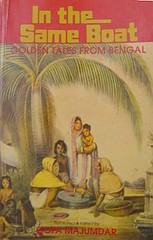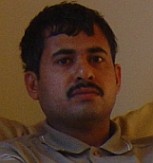In the Same Boat
 I read the book In the Same Boat - Golden Tales from Bengal, a collection of twelve Bengali short stories written by various authors, translated by Gopa Majumdar. All the stories in this collection are narrated in a light-hearted way, with a gentle touch of humor in them, however grim their themes may be. The stories are translated nicely by Gopa Majumdar. I enjoyed reading this book.
I read the book In the Same Boat - Golden Tales from Bengal, a collection of twelve Bengali short stories written by various authors, translated by Gopa Majumdar. All the stories in this collection are narrated in a light-hearted way, with a gentle touch of humor in them, however grim their themes may be. The stories are translated nicely by Gopa Majumdar. I enjoyed reading this book.The first two stories in this collection are Rashomoyee's Ruse and The Promise, written by Prabhat Kumar Mukhopadhyaya. These stories were written in the pre-independence period, and probably belong to a formative period in the history of modern Bengali literature (I wish that the translator had mentioned the year of publication of all the stories). Rashomoyee's Ruse makes us feel as if it is a ghost story in the beginning, in which Khetramohan, the main character starts getting letters from his dead wife, threatening to kill him if he is going to marry again. In The Promise, Bhabatosh, the hero, wants to marry an illiterate and ugly girl, as he thinks such a wife would "stand in the line drawn by him" and obey and serve him like slave. He is firm in his decision until his mother arranges a meeting for him with an "ugly" girl at her home, where he finds a pretty servant girl.
The Bridegroom and Bama are stories by Bibhutibhushan Bandopadhyaya, and have the great writer's mark on them. In The Bridegroom, we see a man's strange attachment with a "pet" plant, and in Bama, we accompany the narrator in his journey to a remote Bengali village, through forests and wastelands infested with dangerous robbers and dacoits. These stories are followed by two from Bonophool, In the Same Boat and The Human Mind - I have read the second story in another collection of short stories by Bonophool.
The Actress and The Beginning are stories by Narendranath Mitra in which the central characters are women fighting with poverty. In the first story, Animesh Chaudhury, a film director, taking sympathy over the financial situation of his friend, offers a role in his film to his friend's wife Labanya. She just has to play the character that she is in her real life, that of a poor mother nursing her sick child, but Labanya is too embarrassed to act and Animesh had to change the plan and cast someone else, sadly. In The Beginning, Arati, the main character is having to take up a job, as her husband's salary is not enough to meet the household expenses. A woman going out for job was considered as disrespectable in the society those days, and hence her in-laws object her in the beginning. But her husband encourages her to take up the job. However, soon the in-laws find her money quite useful, but the husband starts developing an inferiority complex and looks at his wife's movements with suspicion. This brilliant story with excellent characterizations, was filmed by Satyajit Ray as Mahanagar.
Patralekha's Father and The Commander-in-Chief by Satinath Bhaduri are the grimmest stories in this collection, with the characters coming with dark grey shades. In Patralekha's Father, the main character is one who has a strange hobby of sending anonymous gossip letters to various people and then watching their misery and enjoying that. In The Commander-in-Chief, we see a materialistic woman unshaken by her husband's suicide after a quarrel with her. All she is bothered about is to save her face and to take possession of the money that her husband had saved. Both these stories are told in a humorous way that would make us look at these characters with sympathy.
The Gentleman and the Rogue and War and Peace are written by Saradindu Bandopadhyaya, and they are the most witty stories in this collection. The Gentleman and the Rogue is about a man in love, and the burning jealousy in him, while War and Peace is the narrative of a small incident in a naughty boy's life. The plots look like mediocre; But the simple narratives and characterizations makes these stories likeable.


0 Comments:
Post a Comment
<< Home